The AMD Ryzen 9 7900, Ryzen 7 7700, and Ryzen 5 7600 Review: Zen 4 Efficiency at 65 Watts
by Gavin Bonshor on January 9, 2023 9:00 AM ESTCPU Benchmark Performance: Power And Office
Our previous sets of ‘office’ benchmarks have often been a mix of science and synthetics, so this time we wanted to keep our office section purely on real-world performance. We've also incorporated our power testing into this section too.
The biggest update to our Office-focused tests for 2023 and beyond include UL's Procyon software, which is the successor to PCMark. Procyon benchmarks office performance using Microsoft Office applications, as well as Adobe's Photoshop/Lightroom photo editing software, and Adobe Premier Pro's video editing capabilities. Due to issues with UL Procyon and the video editing test, we haven't been able to properly run these, but once we identify a fix with UL, we will re-test each chip.
We are using DDR5 memory on the 12th and 13th Gen Core parts, as well as the Ryzen 7000 series, at the following settings:
- DDR5-5600B CL46 - Intel 13th Gen
- DDR5-5200 CL44 - Ryzen 7000
- DDR5-4800 (B) CL40 - Intel 12th Gen
All other CPUs such as Ryzen 5000 and 3000 were tested at the relevant JEDEC settings as per the processor's individual memory support with DDR4.
Power
The nature of reporting processor power consumption has become, in part, a bit of a nightmare. Historically the peak power consumption of a processor, as purchased, is given by its Thermal Design Power (TDP, or PL1). For many markets, such as embedded processors, that value of TDP still signifies the peak power consumption. For the processors we test at AnandTech, either desktop, notebook, or enterprise, this is not always the case.
Modern high-performance processors implement a feature called Turbo. This allows, usually for a limited time, a processor to go beyond its rated frequency. Exactly how far the processor goes depends on a few factors, such as the Turbo Power Limit (PL2), whether the peak frequency is hard coded, the thermals, and the power delivery. Turbo can sometimes be very aggressive, allowing power values 2.5x above the rated TDP.
AMD and Intel have different definitions for TDP that are, broadly speaking, applied the same. The difference comes from turbo modes, turbo limits, turbo budgets, and how the processors manage that power balance. These topics are 10000-12000 word articles in their own right, and we’ve got a few articles worth reading on the topic.
- Why Intel Processors Draw More Power Than Expected: TDP and Turbo Explained
- Talking TDP, Turbo and Overclocking: An Interview with Intel Fellow Guy Therien
- Reaching for Turbo: Aligning Perception with AMD’s Frequency Metrics
- Intel’s TDP Shenanigans Hurts Everyone
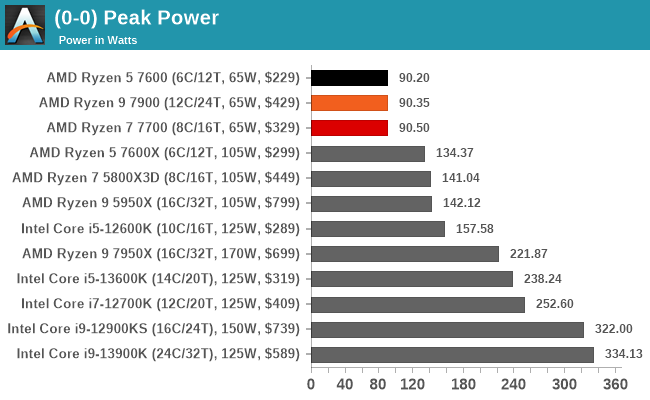
Regarding peak power, all three AMD's Ryzen 7000 65 W series for desktop topped out around 90 W under full load. This figure of 90 W was consistent throughout our power testing, which is within a couple Watts of AMD's Power Package Tracking (PPT) limits (~88W).
Looking at the power consumption of the Ryzen 9 7900 in more detail, we can see how it behaved under full load when running a workload using yCruncher. As we can see from the above graph, when the workload is called, and strain is placed on the Ryzen 9 7900, it immediately rose to 90 W and remained relatively consistent throughout the benchmark. and remained at the 90 W mark for around 193 seconds.
This was the same duration the benchmark took to complete, meaning that the Ryzne 9 7900 remained at its peak power for the full duration.
Office/Web

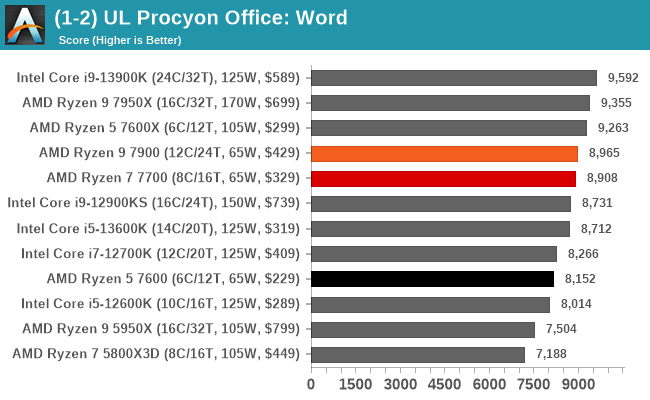
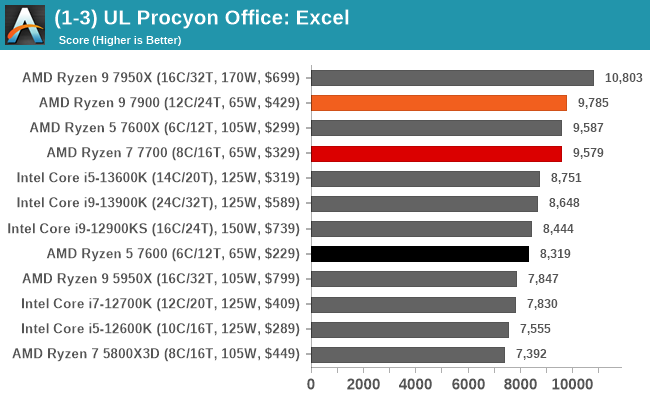
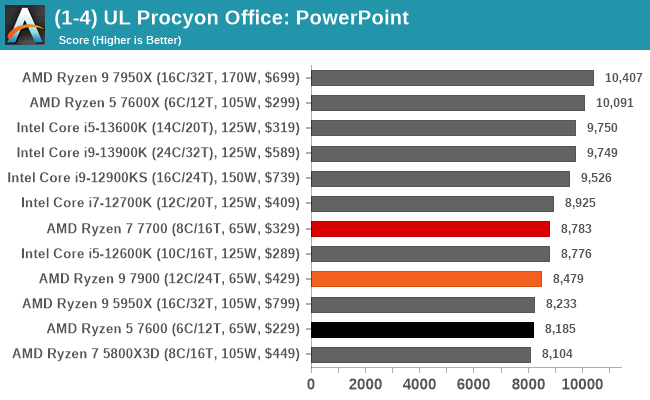
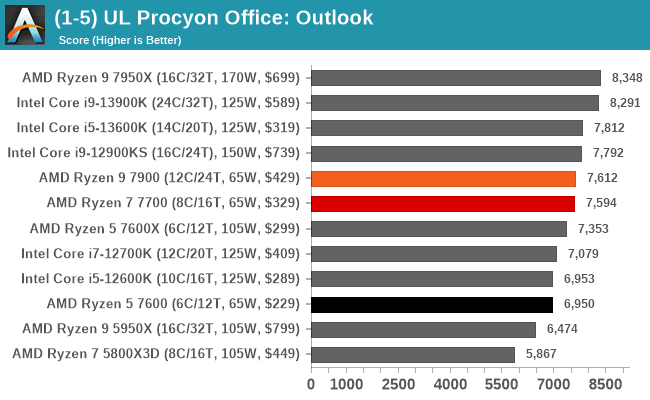
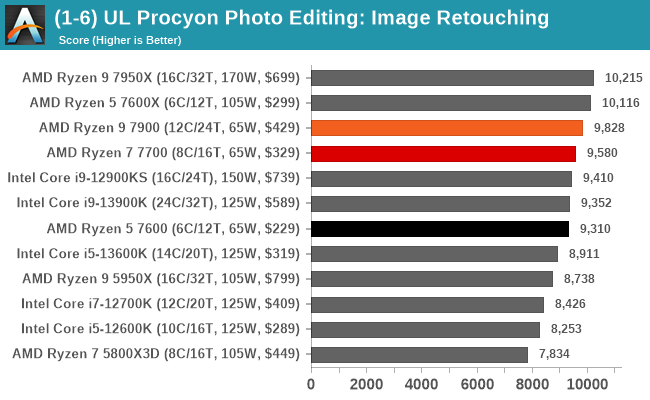
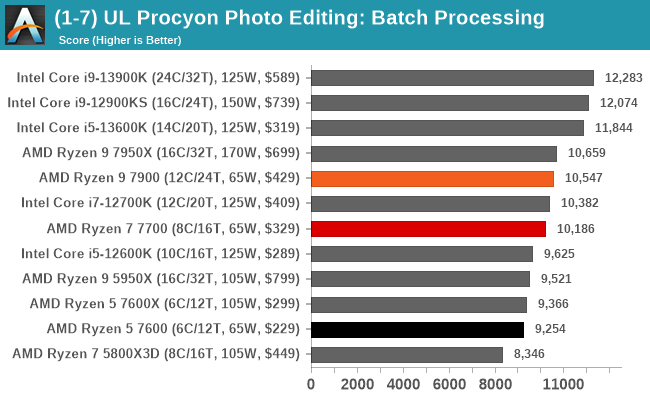
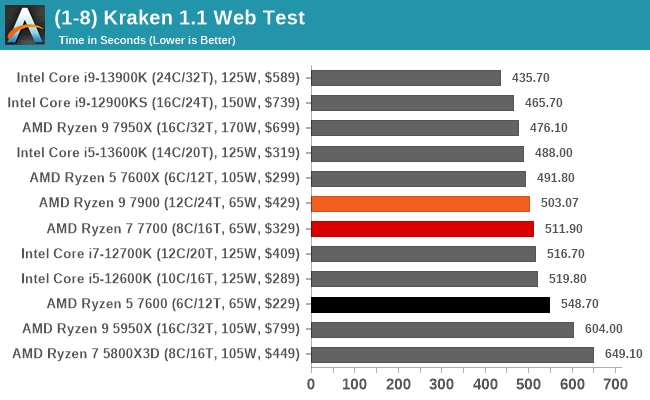
In our office and productivity benchmarks, the AMD Ryzen 9 7900, as expected, performed the best out of the three chips. All three chips in each of the office-based workloads comfortably beat out the Ryzen 9 5950X, which is impressive given the Ryzen 5 7600 is a 6C/12T part at 65 W TDP beating out a much beefier Ryzen 9 5950X that is a 16C/32T part, albeit on an older architecture.


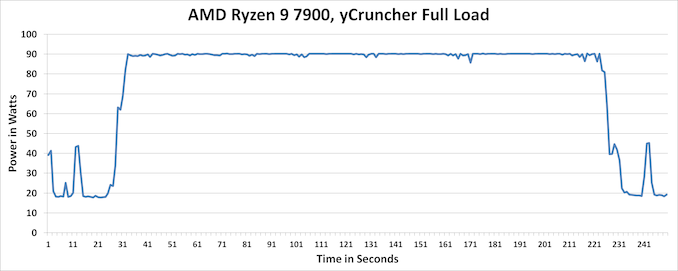








55 Comments
View All Comments
bcortens - Monday, January 9, 2023 - link
My annoyance is mostly that it is misleading - while I understand that companies market these things this way the fact of the matter is that the efficiency is not at 65 Watts, its at 90 Watts. Sure they are spectacularly efficient compared to when running them without power limits but the power limits given by marketing are useless for talking about efficiency because they are just numbers on a slide. AMD could call it TDP 50 Watts and it would be just as meaningful because the real number is so far off.Zucker2k - Monday, January 9, 2023 - link
The 90 watts also doesn't account for iod consumption. So, overall chip consumption is higher than 90 watts.mczak - Monday, January 9, 2023 - link
That's definitely wrong. The PPT number, as the name implies (package power tracking) certainly includes the IOD, it's a limit which applies to the socket. (It does of course not include the B650 (or whatever) chipset but that's of course the same with intel.)Zucker2k - Monday, January 9, 2023 - link
PPT is AMD's version of Intel's PL2 or boosting power level.The power limits reported for the chip and iod are separate.
Gigaplex - Monday, January 9, 2023 - link
PPT is for the whole package. The CCD and IOD do report separate power, but the total package power is also reported and is what is governed by PPT.Gigaplex - Monday, January 9, 2023 - link
PPT does include the IOD, but the TDP is pretty close to the actual power consumption of the CCD.yankeeDDL - Wednesday, January 11, 2023 - link
There's no perfect solution. The gap between what "you think" 65W means in case of AMD, and the reality, is still much smaller than in case of Intel's TDP.Inte'ls 125W CPU can reach well beyond 200W, which is insane (nearly 2x). In case of AMD the difference (explained quite clearly) is much lower (30~40%).
Gigaplex - Monday, January 9, 2023 - link
Another thing to add is that the 65W chips use about 65W for the cores, the rest of the wattage is for the IO.Zucker2k - Tuesday, January 10, 2023 - link
PL2 (boost power level) for Ryzen is tdp x 1.35. So, in this case: 65x1.35 = 87.75. The IOD consumes more than what ll be left here. In any case, the best way to measure these types consumption, from my observations, is to measure from the wall. It usually results in far greater discrepancies than software reports.Atari2600 - Tuesday, January 10, 2023 - link
Source please zucker.